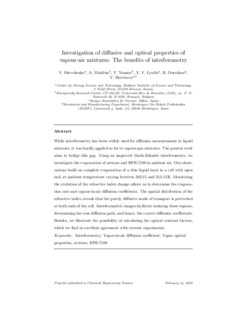
Izenburua
Investigation of diffusive and optical properties of vapour-air mixtures: The benefits of interferometryEgilea
Egilea (beste erakunde batekoa)
Argitalpen data
2021Beste erakundeak
IkerbasqueSkolkovo Institute of Science and Technology SKOLTECH (Russia)
Université Libre de Bruxelles
Bertsioa
PostprintaDokumentu-mota
ArtikuluaArtikuluaHizkuntza
IngelesaEskubideak
© 2021 Elsevier Ltd.Sarbidea
Sarbide bahituaBahituraren amaiera data
2023-04-30Argitaratzailearen bertsioa
https://doi.org/10.1016/j.ces.2020.116433Non argitaratua
Chemical Engineering Science Chemical Engineering Science. Vol. 233. N. artículo 116433, 2021Argitaratzailea
Elsevier Ltd.Gako-hitzak
Interferometry
Vapor-in-air diffusion coefficient
Vapor optical properties
Acetone ... [+]
Vapor-in-air diffusion coefficient
Vapor optical properties
Acetone ... [+]
Interferometry
Vapor-in-air diffusion coefficient
Vapor optical properties
Acetone
HFE-7100 [-]
Vapor-in-air diffusion coefficient
Vapor optical properties
Acetone
HFE-7100 [-]
Laburpena
While interferometry has been widely used for diffusion measurements in liquid mixtures, it was hardly applied so far to vapour-gas mixtures. The present work aims to bridge this gap. Using an improve ... [+]
While interferometry has been widely used for diffusion measurements in liquid mixtures, it was hardly applied so far to vapour-gas mixtures. The present work aims to bridge this gap. Using an improved Mach–Zehnder interferometer, we investigate the evaporation of acetone and HFE-7100 in ambient air. Our observations build on complete evaporation of a thin liquid layer in a cell with open end, at ambient temperature varying between 283.15 and 313.15 K. Monitoring the evolution of the refractive index change allows us to determine the evaporation rate and vapour-in-air diffusion coefficients. The spatial distribution of the refractive index reveals that the purely diffusive mode of transport is perturbed at both ends of the cell. Interferometric images facilitate isolating these regions, determining the true diffusion path, and hence, the correct diffusion coefficients. Besides, we illustrate the possibility of calculating the optical contrast factors, which we find in excellent agreement with current experiments. [-]




















